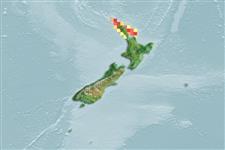分类 / Names
俗名 | 同种异名 | Catalog of Fishes(属, 种) | ITIS | CoL | WoRMS | Cloffa
Teleostei >
Ovalentaria/misc (Various families in series Ovalentaria) >
Plesiopidae (Roundheads) > Acanthoclininae
Etymology: Acanthoclinus: Greek, akantha = thorn + Greek, klinein, kline = sloping and bed, due to the four apophyses of sphenoid bone (Ref. 45335); marilynae: Named after Marilyn Hardy (Ref. 9003).
Environment: milieu / climate zone / depth range / distribution range
生态学
海洋 居于水底的; 非迁移的; 深度上下限 0 - 80 m (Ref. 9003). 溫帶; 34°S - 37°S, 172°E - 176°E (Ref. 56304)
Southwest Pacific: endemic to New Zealand.
西南太平洋: 紐西蘭的特有種。
大小 / 重量 / 年龄
Maturity: Lm ? range ? - ? cm
Max length : 17.0 cm TL 雄鱼/尚未辨别雌雄; (Ref. 9003)
简单描述
检索表 | 型态特徵 | 形态测量图
背棘 (总数) : 19; 背的软条 (总数) : 4 - 5; 臀棘: 10 - 12; 臀鳍软条: 3 - 5. Head and body mottled light to dark brown to deep chocolate brown throughout. Fin membranes greyish brown to black with tips of dorsal and anal fins white or orange. Distinguished from other rockfishes in having 10-12 spines in the anal fin.
头部与身体有斑点的淡色到深褐色的到深褐色始终。 鳍薄膜灰褐色的黑色有背鳍与臀鳍的顶端白色或橘色的。 与其他的礁石鱼类在臀鳍中有 10-12 棘区分了。
Adults are common in the subtidal zone but may be found in rock pools. Feed on small fishes such as triplefins (Ref. 9003). Eggs are guarded by the male parent (Ref. 205).
常见于亚潮间带的区域在岩石区潮池中但是可能被发现。 吃小鱼例如三鳍鳚。
Life cycle and mating behavior
Maturities | 繁殖 | Spawnings | Egg(s) | Fecundities | 仔鱼
Eggs are guarded by the male parent (Ref. 205).西南太平洋: 紐西蘭的特有種。
Paulin, C. and C. Roberts, 1992. The rockpool fishes of New Zealand (Te ika aaria o Aotearoa). Museum of New Zealand (Te Papa Tongarewa). 177 p. (Ref. 9003)
人类利用
渔业: 没有兴趣
工具
特别资料
下载 XML
网络资源
Estimates based on models
Phylogenetic diversity index (Ref.
82804): PD
50 = 0.5312 [Uniqueness, from 0.5 = low to 2.0 = high].
Bayesian length-weight: a=0.00457 (0.00180 - 0.01158), b=3.10 (2.87 - 3.33), in cm total length, based on LWR estimates for this (Sub)family-body shape (Ref.
93245).
营养阶层 (Ref.
69278): 3.7 ±0.61 se; based on food items.
回复力 (Ref.
120179): 中等的, 族群倍增时间最少 1.4 - 4.4年 (Preliminary K or Fecundity.).
Fishing Vulnerability (Ref.
59153): Low vulnerability (10 of 100).
